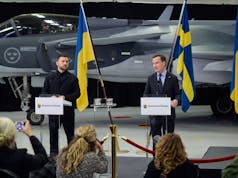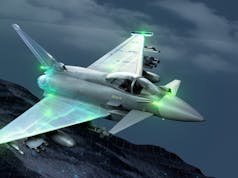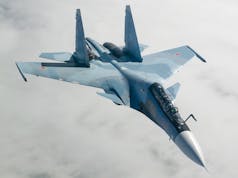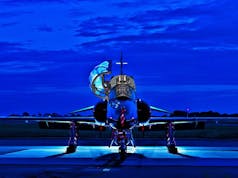Hybrid Air Vehicles Ltd (HAV) has announced the reservation of three Airlander 10 hybrid aircraft for military applications, marking the first defence order from the company’s $3.7 billion military pipeline.
The aircraft have been reserved by an undisclosed defence contractor aiming to demonstrate the platform’s potential for intelligence, logistics, and surveillance roles.
The Airlander 10, initially designed for civil certification, combines airship and fixed-wing technologies to deliver long-endurance, fuel-efficient flight. Its large, modular cabin allows for rapid reconfiguration, making it suitable for missions ranging from intelligence, surveillance and reconnaissance (ISR) to heavy transport and drone swarm deployment. HAV says the aircraft can remain airborne for up to five days without refuelling and can operate from almost any flat surface, including water.
In a statement, HAV described the aircraft’s potential to address emerging global threats. It highlighted applications such as elevated sensing for missile defence, counter-drone and drone swarm operations, and maritime patrol. “Airlander lifts a sensing payload of over three tonnes, enabling high-powered radars to remain aloft for days on end,” the company noted, adding that the platform can provide persistent surveillance and communication coverage over wide areas at a fraction of the cost of conventional aircraft.
George Land, HAV’s Executive Director of Sales, said, “Its versatility, high payload, and endurance have always given Airlander 10 obvious advantages over other aircraft in C4ISR. As warfare evolves to meet current threats this capability is ever more valuable. We are pleased to be working with an undisclosed customer to provide three aircraft for further customisation. We expect other military reservations to follow.”
The aircraft are expected to begin testing in 2027, with entry into service following type certification. Each Airlander 10 can carry up to 10 tonnes of cargo or 100 passengers, while future variants could scale up to lift 200 tonnes for global logistics and humanitarian operations.
Production of the Airlander 10 will take place at a new facility in South Yorkshire, which HAV says will form the centrepiece of a green aerospace manufacturing hub in the UK.














Leaving the all very mysterious question of who will be the end user to our imaginations. Is this so old a technology that it won’t need a dual use export license from the UK?
Don’t know, It’s all up in the air at the moment.
Very funny.
“Green Aerospace Manufacturing Hub”
To what degree is it Green ?
Is it the end product or the various stages involved in it’s production and Infrastructure ?
Airlander is ridiculously fuel efficient compared with helicopters and aeroplanes, IIRC it’s on about the same carbon footprint level as high speed trains and better than ferries with none of the infrastructure requirements.
The problem is that it’s really expensive per unit cargo, both because it’s an airship and because it isn’t in production yet.
Yes, I just read all the Corporate Guff on the site (talk of making inroads into existing Air Cargo flights with the usual American Hard Sell Wording!)
The fact it may be “Rediculously fuel efficient” is just a small part of the whole “Green” process though, It’s how green it is from the “drawing board” to the air.
How Green are it’s parts ?
How green is the build process ?
How green is it’s power usage during production ?
How environmently friendly is it over all ?
We all seem to suck up this Green Speak without question.
The perfect is the enemy of the good enough. It doesn’t have to be absolutely net zero if it’s substantially better than the alternatives.
So, Is it better then ?
Is it more green throughout it’s journey from concept to disposal ?
What is green? Does it use fewer fossil fuels that cause global warming than an equivalent airplane? Well of course. It it greener in manufacturing and disposal? I’d say without a doubt. However, it gobbles up helium, a non-renewable resource normally got from refining natural gas or from direct drilling and extraction near natural gas deposits. So there’s that. It’s possible to extract helium out of the air, but there’s very little of it. Net Zero yes. Renewable not really.
So all the materials used are Green, the Premises/buildings have all been built using Green materials, delivered on green lorries and the energy used is green too ?
The selling of this seems to play big on it’s green credentials but some of us know there is more to it than that.
It’s all a Grey area if you ask me.
It’s no more environmentally unfriendly to produce than any other large aircraft, especially with all of the composites in modern airliners.
But saving fuel is a huge advantage, because to fly 3000 miles takes a normal aircraft tens of tonnes of fuel and produces tens of tonnes of CO2. If that can be cut by 80% as HAV claim then a well-used aircraft will definitely be better over its lifetime.
But for me the usefulness isn’t in how green it is, and I think it would be hypocritical for the RAF to start judging its aircraft by their green-ness when their eventual purpose is destruction. The usefulness is that it has twice the mission payload of a Merlin, not too far off a P8, but has 10 times the endurance of either of those. A crew of 4 or 5 can live on board for a working week and follow a Russian warship, submarine or cargo ship the whole time, or lift 10 tonnes of cargo to the middle of nowhere. The website has a load of guff about SWaP, but a more accurate description would be that it has the capacity of an airliner, the performance of a helicopter and the endurance of a small ship.
As you may be able to tell, I am a {slight} Airlander fanboy.
Yes, the Website plays the Green hand quite heavily, personally I just detest all the corporate BS that people seem to suck up with gusto.
Bottom line is this has all been done before, many times and with many technological improvements (Hindenberg) Their website talks about Cargo Aircraft making up just 1% of world trade and Airlander offers so much more.
Yeah like sure it does and good luck replacing the tens of thousands of obsolete cargo aircraft. !!!!
Apart from the BS stuff, I like the whole concept asa Niche capability.
You need to discover Bikes mate, Bikes are fun, maybe Girls too !!!
I recall reading that the British Army tested something like this on the quiet at Middle Wallop over a decade ago.
Nothing came of it then either it seems.
Seems good for ISTAR though if we ever end up buying any.
Ah the R101 !!!!!
If you say so mate. I’m not “up” on my aerostats!
Goes to look up 101.
I was reverting back to sillyness. The R101 was Britains airship “Titanic” of the 1920/30’s.
I have a bad vibe about anything Airship shaped !
At least we also had R100 which actually worked well. It would have been a much more interesting world if neither R101 nor the Hindenburg disaster had happened- the UK government were planning huge fleets of airships to fly to and from the Empire, and a massive investment in infrastructure to go along with it.
All ready to set the world on fire then !
Every air lander has a British racing green strip to make it go faster.
I fear the next stage will be getting people to pay to have their names on the side, just like Vulcan and Thrust 2.
Lots of money went into lots of shiny new vehicles and associated paraphanalia with those two projects.
They’ve already done a crowdfund for their air licensing campaign where a £500 donation got you a flight one one of the first production Airlanders.
So long as it gets the things into the air, all to the good. I was very tempted though, as I’m unlikely to be taking airship trips around the Canaries or the Balearics or wherever that Spanish airline wants to use them.
Well the life boat service will pop your name on.. for a bit of your estate… maybe that is not such a bad idea.. public donations to support the armed forces gets you name on the side of one of the aircraft protecting us all.. it would give people connection and pride.
66 million names on a handfull of Aircraft lol !
Yep imagine a twenty quid each and we could crowd fund 10 years worth of RAF fast jet purchases…
I’m in,
What’s the commision % ?
That could be achieved- for the Navy at least- by deepening the town association with warships so that the inhabitants can help crowdfund the upkeep and upgrades to the ships.
It would be a poor propaganda play for our armed forces to rely on public goodwill for funding, though.
I’m not so sure it would to be honest.. a consolidated review of NHS charities showed holding of 500million in one year.. if you look at hospice functions they are essentially funded by public donations with the NHS having contracts with the hospice charities that provide only about 30% of their funding.. lots of other third sector providers contract with the NHS at or below cost due to their charitable status.. so for all our hospice functions the NHS paid .5 billion pounds the general public then raised 1.3 billion.
A lot of our emergency and rescue services are entirety charity funded Our English and Welsh air ambulance services are entirety funded by donations.. the NHS does not fund at all.. that’s another 60million a year. BASICS doctors cars are generally only partially supported by NHS areas and most of their equipment is provided by charity donations ( 1.5 million over 5 years)
The life boat service is entirely charity based that’s another 200million a year.
Finally all our English and Welsh mountain and upland rescue services are funded by charities that’s 47 teams at about £40,000 each a year ( about 2 million a year)
So as you can see about 2 billion a year in charity supports critical parts of our healthcare and emergency systems.
What’s the going rate for a commercial Airlander? Someone’s making a pretty expensive commitment to HAV here, at least £100m IIRC for three aircraft. If it’s a UK contractor it could only really be BAE, but HAV have been doing a lot of work in the US around Pacific logistics so it might be that.
The requirement for three separate aircraft is also interesting. One each for AEW, logistics/drone mother ship and MPA/ISR?
“ Hybrid Air Vehicles Ltd (HAV) has announced the reservation of three Airlander 10 hybrid aircraft for military applications, marking the first defence order from the company’s $3.7 billion military pipeline”
How can the first defence order for three units equate to a $3.7Bn military pipeline?
Or am I missing something?
Corporate BS talk, It’s been “Big’d” up for years.
These grand projects come along every so often, suck up huge amounts of money making people rich and then disapeer without trace.
Hopefully this will buck that trend and become the success It seems to be on the website.
I think their first commercial order, from Spain, was increased to 20. When they finally get the licencing sorted out they look to be sitting pretty.
Spain placed a Reservation for 10 then 20, not sure if they can yet be quoted as actual sales.
I suspect that is their assumptions on the future available market..or otherwise know as pie in the sky.
Speculating a little as to final destination, it might be significant that earlier this year, HAV set up a subsidiary in the US, its President being a former USN officer.
Yes the USMC love the idea because it could lift cargo to uninhabited atolls over thousands of miles with no existing infrastructure and at a speed relevant to a Taiwan invasion scenario.
Airlander 50 would be even more useful.
I understand the original design was for the Americans who then got out but are again back in ?
The US army wanted an unmanned airship that would sit over their camps in Afghanistan for a month at a time with cameras to spot any surface movements.
They pulled out because the original Airlander design wasn’t as flexible to deploy as they had wanted (needed a slight runup to take off, couldn’t just be parked in a corner of an airfield and left alone).
They have now decided those problems aren’t significant in the maritime environment and want it for long range logistics.
Hence the $3.7 Billion then, I guess.
Yup, the USMC are scared witless that China is going to cut off all of their reinforcement and supply options in the Pacific so they are rapidly trialling things like LUSVs, semi-submersibles and ekranoplans to keep remote atolls sustained in a big war.
There is even a variant of Mojave that carries cargo in boxes under the wings!
We had aerostats above our bases in Helmand I understand, part of something called Base ISTAR or Cortez?
Yes, DB mentioned something about using aerostats with IR cameras above the bases.
I think the idea with Airlander (or LAMV as it was called) was that it would mount several Watchkeeper-style huge cameras to keep a very large area under constant surveillance.
We can always hope that this is something from the defence investment plan that is embargoed until the plan is published.
I suppose the really interesting question would be could one of these touchdown and refuel resupply on an Elizabeth class.. 5 days loiter means it would be the ultimate in AEW.
Only if the decks were empty and the ship was sailing.
Both points are a bit Iffy.
I would be very surprised if an Airlander order were announced in the DIP, however much I love the idea. The first Airlanders from the new production line will fly no sooner than 2028, so we’d have these in service in 2030 most likely. Long term they’d be a fabulous thing for maritime patrol and AEW, but we have more urgent priorities at the moment. If this order IS actually BAE, they might be looking to have a programme of demonstrations to the MoD sooner than that as a precursor to a larger order, but it is most likely the Americans searching for an answer to their Pacific logistics problems, given the amount of speculative money three HAV10s represents.
I once emailed HAV about whether they could land it on a carrier, the future capabilities guy sort of went ‘we’ve never really thought about it but you couldn’t with our current version’. However, a lot of the feedback they have been getting around industry requirements has led them to want VTOL for future variants, and I think that could work on the QEs if you cleared the port sponsons. You can’t use an airship mast on a ship like the USN used to do because it doesn’t have enough hydrostatic lift.
I sort of remember that first version about ten years ago, it had issues with Wind, I guess your Guy probably knew it would be a bit tricky for any future Carrier use without some serious mods.
Question is though, Would a Carrier actually need to carry it, if so, I’d imagine a whole list of Issues not least H&S ones plus Weather and Sea state and Deck parking.
It will be interesting to see what actually comes from all this.
You need to change your Gravatar mate.
What’s wrong with it?
Should be a Saro Princess, I changed it to get away from the same black and white scheme as you.
Nothing is wrong with it mate, thought given your evident and admitted regard for Airlander you’d have an aerostat Grav.
Flying-boat, Air-ship, all the same really!
I just love the Princess, it was so obviously obsolete even when it was designed but Saro went ahead and made it beautiful anyway.
10 Centaurus engines each of 2500hp, easily 4 times as much power as a Lancaster!
It can land on water. Provided one of the Tides could find its way to somewhere sheltered, that would be a better solution.
The main issue with using HAV for AEW is the operating altitude. The current Airlander 10 and proposed Airlander 50, are supposed to max out at 20,000ft. Which admittedly is still better than the Merlin with Crowsnest. The operating sweat spot for AEW is 30,000ft or higher, as this gives a better radar horizon of over 390km compared to 20,000ft, where its about 320km. In radar terms this also kind of matches the sweat spot for S-band radars. Where they don’t need so much power to get a really good detection distance. Reaching 30,000ft or above would also remove a lot of the environmental factors such as high winds, which the HAV won’t be able to cope with. Reading on why the HAVs are limited to 20,000ft, it seems to be centred on the strength of the envelop material to resist the pressure differential (higher pressure inside, lower pressure outside). I wonder if there’s scope for looking at a stronger material or increasing the thickness of the current material, without overly affecting performance?
The additional benefit of using the HAV, is that the radar antenna is housed in a benign environment within the envelope. Due to the payload capabilities and the overall size of the HAV, you can maximise the size of the antenna array, as well as picking an array shape that is more efficient at generating a more circular beam shape, for example Octagonal. As a more circular beam means there’s more energy packed into a smaller area, which increases transmission range. This shape and size would be either impracticable or impossible to mount on a fixed or rotary wing platform. Thinking about it, much like if the radar was fitted to a ship, it would be possible to do maintenance on the radar whilst in flight.
The Airlander 50 though planned to be significantly bigger than the current 10 version, opens up a lot more possibilities. As an increased payload means there’s now greater scope to expand the mission parameters, but also the operating infrastructure for a crew. Where perhaps the patrol duration is over 7 days. If the HAV is being considered for long distance passenger ferry flights. Then the infrastructure to maintain two shifts/watches will be no different. Therefore, the infrastructure to support the crew with sleeping accommodation, rest area, “gym”, galley and messing, along with an operations centre etc should all be easily catered for.
I believe the HAV would be capable of doing a replenishment at sea (RAS) using a pseudo vertical replenishment (VETREP) technique. Where a support vessel is sailing at X speed and the HAV matches it. Transferring fuel etc via lines and hoses should be doable, perhaps even crew.
A question that has been floating around my head. whilst thinking about the HAV and its uses, is could it launch and recover UAVs whilst in flight? The Airlander 10 is supposed cruise at around 100kph (60mph-ish). Dropping a UAV into the airflow would be sufficient, especially at altitude. But how could it be recovered? I know Airbus has done trials using the A400M of recovering UAVs over the ramp whilst in flight. So perhaps its not such a mad idea. Being able to operate as a mothership, along with the ability to launch and recover UAVs. Would significantly increase the operational capability of the HAV, especially for maritime surveillance, but also for anti-submarine warfare (ASW). If only Gerry Anderson (of Thunderbirds fame) was still around, I’m sure he’d design and build it!
At 60mph, it would take days to get on station and probably struggle to keep up with any Submarine in a head wind !
I think I read the Blurb which said it oporated between a Helicoptor and Aeroplanes speed range, maybe I got that wrong, dunno.
If it’s a 60mph airbag, I can’t think It will feel safe transporting soldiers in the SCS especially at such low levels either.
RE radars, I’m not sure it would be possible to have an internal array on Airlander because of the twin hull arrangement and the ballonets- I think there are cables linking the upper and lower surfaces a bit like a giant paddle board so it would be difficult to find a big enough open space.
Surely there would be lots of room around the payload cabin for four big circular arrays, for constant coverage? Or if not just do what the US did and put a giant rotating array underneath in a vast radome.
Sounds a bit like WW1 Trench warfare, Men in balloons with Binoculars and Parachutes (later on) .